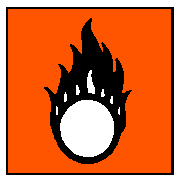International Chemical Safety Cards
| SODIUM CHLORATE | ICSC: 1117 |
SODIUM CHLORATE |
 |
 |
| TYPES OF HAZARD/ EXPOSURE |
ACUTE HAZARDS/ SYMPTOMS |
PREVENTION | FIRST AID/ FIRE FIGHTING |
| FIRE | Not combustible but enhances
combustion of other substances. Many reactions may cause fire or explosion. Gives off
irritating or toxic fumes (or gases) in a fire. |
NO open flames, NO sparks, and
NO smoking. NO contact with flammable substances. NO contact with combustible and reducing
materials, and organic materials. |
Water in large amounts. |
| EXPLOSION | Risk of fire and explosion on
contact with flames, sparks and organic materials (such as clothing, leather and paper) or
other incompatible materials. |
|
In case of fire: keep drums,
etc., cool by spraying with water. |
| EXPOSURE | |
PREVENT DISPERSION OF DUST!
AVOID EXPOSURE OF ADOLESCENTS AND CHILDREN! |
|
| INHALATION | Cough. Sore throat. |
Local exhaust or breathing
protection. |
Fresh air, rest. Refer for
medical attention. |
| SKIN | Redness. |
Protective gloves. Protective
clothing. |
First rinse with plenty of
water, then remove contaminated clothes and rinse again. Refer for medical attention. |
| EYES | Redness. Pain. |
Safety goggles or eye protection
in combination with breathing protection. |
First rinse with plenty of water
for several minutes (remove contact lenses if easily possible), then take to a doctor. |
| INGESTION | Abdominal pain. Blue lips or
fingernails. Blue skin. Diarrhoea. Nausea. Shortness of breath. Unconsciousness.
Vomiting. |
Do not eat, drink, or smoke
during work. |
Rinse mouth. Refer for medical
attention. |
| SPILLAGE DISPOSAL | STORAGE | PACKAGING & LABELLING | ||
| Sweep spilled substance into
sealable containers. Wash away remainder with plenty of water. Do NOT absorb in saw-dust
or other combustible absorbents (extra personal protection: P2 filter respirator for
harmful particles). |
Separated from combustible,
flammable, organic or other readily oxidizable materials. Dry. Keep in a well-ventilated
room. Avoid storage on wooden floors. |
O symbol Xn symbol R: 9-22 S: 2-13-17-46 UN Hazard Class: 5.1 UN Packing Group: II |
||
| SEE IMPORTANT INFORMATION ON BACK | ||||
|
||||